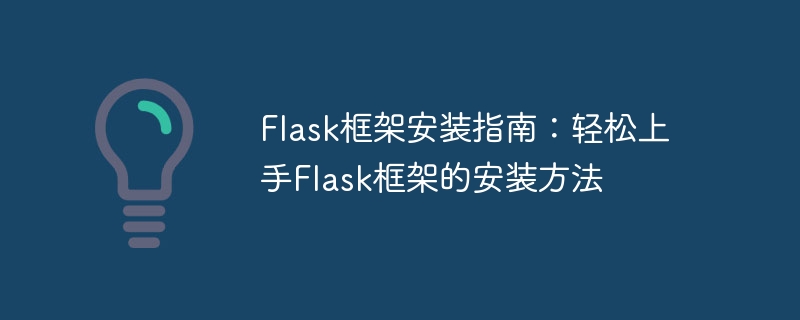

Flask Framework Installation Guide: Easy to get started with the installation method of Flask framework, specific code examples are required
Introduction:
Flask is a lightweight web application Framework, developed based on Python. It is easy to learn and powerful, suitable for rapid development of small or medium-sized web applications. This article will introduce how to install the Flask framework and provide specific code examples to help readers easily install the Flask framework.
1. Preparation
Before starting to install the Flask framework, we need to ensure that the Python environment has been installed in the system. If Python is not installed on your system, please install Python first.
2. Install the Flask framework
The installation of the Flask framework is very simple and can be installed through the Python package management tool pip. Enter the following command in the console or terminal to install the Flask framework:
pip install flask
The system will automatically download and install the latest version of the Flask framework.
3. Verify installation
After the installation is completed, we can verify whether the Flask framework is successfully installed through a simple sample code. Create a Python file named app.py. The code in the file is as follows:
from flask import Flask
app = Flask(__name__)
@app.route('/')
def hello_world():
return 'Hello, Flask!'
if __name__ == '__main__':
app.run()Execute the following command to start the Flask application:
python app.py
Enter # in the browser ##http://localhost:5000/, if you see "Hello, Flask!" displayed on the page, it means that the Flask framework has been successfully installed and running.
In actual development, we may need to perform some configurations on the Flask application. For example, modify the application host and port number, set debugging mode, etc. Flask provides a configuration file
config.py, which we can modify to configure the Flask application. The following is a simple configuration file example:
DEBUG = True HOST = '0.0.0.0' PORT = 5000
app.py and modify the application configuration:
from flask import Flask
from config import *
app = Flask(__name__)
app.config.from_object(__name__)
@app.route('/')
def hello_world():
return 'Hello, Flask!'
if __name__ == '__main__':
app.run(host=HOST, port=PORT, debug=DEBUG)app. py file, the Flask application will be started according to the settings in the configuration file.
This article introduces the installation method of the Flask framework and provides specific code examples. By referring to this article, readers can easily install and run the Flask framework, laying the foundation for subsequent development of web applications.
The above is the detailed content of Learn how to install the Flask framework on your system: The simple steps to install the Flask framework. For more information, please follow other related articles on the PHP Chinese website!
 How to solve the problem of missing ssleay32.dll
How to solve the problem of missing ssleay32.dll
 How to open the terminal window in vscode
How to open the terminal window in vscode
 Is A5 bigger or B5 paper bigger?
Is A5 bigger or B5 paper bigger?
 The role of parseint function
The role of parseint function
 The difference between arrow functions and ordinary functions
The difference between arrow functions and ordinary functions
 How to define an array
How to define an array
 How much is Snapdragon 8gen2 equivalent to Apple?
How much is Snapdragon 8gen2 equivalent to Apple?
 fil currency price real-time price
fil currency price real-time price
 SpringBoot project building steps
SpringBoot project building steps




